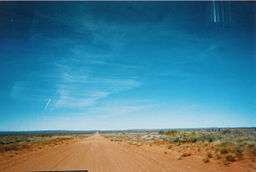Great Sandy-Tanami desert




The Great Sandy-Tanami desert is a World Wildlife Fund ecoregion of Western Australia extending into the Northern Territory.[1]
Location and description
This very large ecoregion consists of the Little Sandy Desert, Great Sandy Desert, and Tanami Desert Interim Biogeographic Regionalisation for Australia (IBRA) regions,.[2][3] The landscape is desert sands with areas of wooded steppe and shrubby grassland. The Great Sandy Desert is a large area of red desert sand dunes, while the Tanami Desert to the east is flat sand broken up with areas of hills. One prominent landmark in the region is the large sandstone rock Uluru. The climate is hot and dry and the area is mostly uninhabited.
Flora
The vegetation is very thin and consists of spinifex grass and saltbush shrubs that are adapted to the desert conditions. There are also occasional acacias and desert oaks.
Fauna
Much of the wildlife of this hot climate is nocturnal including the rabbit-sized marsupial the Bilby and the Rufous hare-wallabies of the Tanami Desert. The wildlife of these deserts includes communities of wild camels, descendants of animals brought here as transport in earlier times.
See also
References
- ↑ World Wildlife Fund (2001). "Great Sandy-Tanami desert". WildWorld Ecoregion Profile. National Geographic Society. Archived from the original on 2010-03-08., written by the World Wildlife Fund, from National Geographic magazine.
- ↑ Environment Australia. "Revision of the Interim Biogeographic Regionalisation for Australia (IBRA) and Development of Version 5.1 - Summary Report". Department of the Environment and Water Resources, Australian Government. Archived from the original on 2006-09-05. Retrieved 2007-01-31.
- ↑ IBRA Version 6.1 data
Further reading
- Thackway, R and I D Cresswell (1995) An interim biogeographic regionalisation for Australia : a framework for setting priorities in the National Reserves System Cooperative Program Version 4.0 Canberra : Australian Nature Conservation Agency, Reserve Systems Unit, 1995. ISBN 0-642-21371-2
Coordinates: 21°06′54″S 127°11′33″E / 21.115°S 127.1925°E
